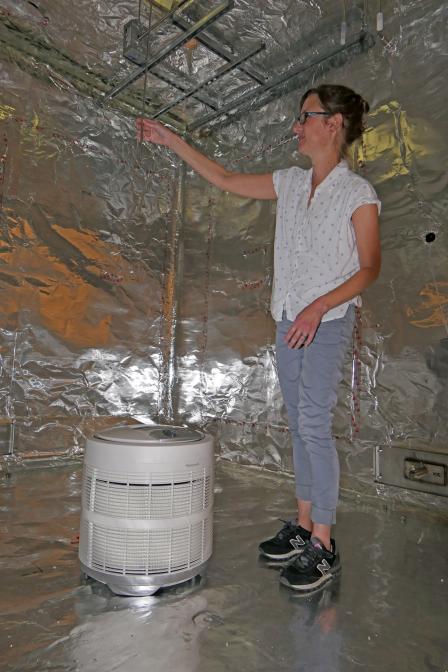Understanding Indoor Air Quality During Wildfires
Published January 22, 2020
 EPA's Amara Holder testing air cleaners in the lab.When communities are impacted by wildfire smoke for days and weeks, residents want to know what steps they can take to reduce their exposure outdoors and indoors. Building owners are interested in effective actions to protect their occupants. That was the situation in Missoula, Montana, during the summer of 2017 when the community and surrounding areas experienced significant smoke impacts from nearby forest fires.
EPA's Amara Holder testing air cleaners in the lab.When communities are impacted by wildfire smoke for days and weeks, residents want to know what steps they can take to reduce their exposure outdoors and indoors. Building owners are interested in effective actions to protect their occupants. That was the situation in Missoula, Montana, during the summer of 2017 when the community and surrounding areas experienced significant smoke impacts from nearby forest fires.
The Missoula City–County Health Department (MCCHD) was inundated with inquiries about the risks of wildfire smoke, actions to take, and how to create clean air spaces indoors. Following the smoke episodes, the health department was interested in learning more about effective risk reduction strategies they can share with building owners and the public. As a result, the health department and other partners have teamed up with EPA researchers to conduct an indoor and outdoor air measurement study.
EPA researchers and partners placed over 30 low-cost air sensors that measure fine particulate matter (PM2.5)—the main component of smoke that is of great health concern— inside 18 buildings and outdoors at 16 locations throughout Missoula. The buildings are public or commercial buildings that range in air management methods from window-only ventilation to central air filtration and represent locations the public may visit during a summer smoke episode. Buildings include fitness centers, museums, churches, office buildings, a senior citizen center, and university facilities. The health department collected and sent the recorded data from the sensors to researchers for analysis.
The goal of the field study is to learn more about how air cleaning and ventilation practices impact indoor air quality during wildfire events. A complementary laboratory study in Research Triangle Park, North Carolina, will evaluate the effectiveness of portable air cleaners and air filtration systems in removing PM2.5 under simulated pollution levels found during wildfires.
When the lab study begins, researchers will test five portable air cleaners, ranging from a do-it-yourself cleaner composed of a box fan with attached heating, ventilation, and air conditioning (HVAC) filter to commercial high-efficiency particulate air (HEPA) air purifiers. The cleaners will be evaluated for their effectiveness at removing PM2.5 and other toxic pollutants, as well as their ease of use and cost to operate. Wood, tree litter, and duff collected from the forests surrounding Missoula will be burned to create the smoky conditions needed to evaluate the air cleaners. These real-world fuels will enable researchers to create emissions in the laboratory, similar to wildfires in the area. They plan to test the air cleaners at levels slightly above the PM 2.5 air quality standard and at higher levels that can occur during wildfires.
The research has involved local partners from the beginning to identify what information they need to effectively communicate actions that building owners and the public can take to reduce public health risk during smoke episodes. In addition to the health department, the University of Montana in Missoula is participating.
Sarah Coefield, air quality specialist with MCCHD says, “We’re excited to be partnering with the EPA on this study. The data from this field study will show the variability of indoor air quality in buildings across our community and will help us better understand how much outdoor air comes inside under real-world conditions. We expect the results will help us provide our community with practical advice about creating cleaner air spaces during wildfire smoke events.”
The field work in Missoula has ended for the wildfire season, and EPA is now conducting a similar study of indoor and outdoor air quality associated with wildfire smoke and other high air pollutants with the Hoopa Valley Tribe in northern California.
This project is part of EPA’s solutions-driven research initiative, which emphasizes working directly with stakeholders to develop solutions to public health and environmental concerns. The research findings are expected to be applied to help communities prepare for wildfire smoke and provide answers about indoor air quality and air cleaning devices.
Amara Holder, one of the EPA research engineers leading the project explains, “This research approach has been gratifying, as we are designing and quickly implementing studies to address time-sensitive questions about smoke episodes and how to protect the public when community members may have limited choices other than to stay indoors. This research will be impactful because of the input and support of our local partners.”
Editor's note: A version of this story was originally published in EM Magazine.
